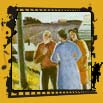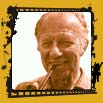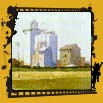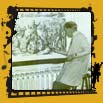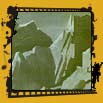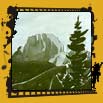 Heritage Community Foundation Presents
Heritage Community Foundation PresentsAlberta Online Encyclopedia
 |
 |
 |
|||
     |
Legacy Article "My Father, H.G. Glyde"
Alberta is no longer a frontier province, but a land of
settled towns and communities, where many now have their roots in the
soil, where their families are growing up, young Albertans, part of the
land, with a love for it, and knowing its moods. From these young people must come our indigenous painters, and perhaps in the years to come, there may a be a renaissance of Canadian painting springing up with a wholesome, personal flavor of the west, getting its inspiration from the rugged barriers of the mountains, and the stark realities of life on the prairies. When my father wrote these words, he had been in Alberta 12 years. By then, he had taught in Calgary during the wintertime, at the Banff School of Fine Arts for the summer session and, for two or four week periods in the springtime, he conducted community art courses in Vegreville, Vermilion, Grande Prairie, Medicine Hat and Lethbridge. In 1946, he moved to Edmonton to begin the Art Department at the University of Alberta. He had come to know and love this province, choosing to stay here because he felt that he could make a contribution.
Patricia Ainslie, Curator of Art at the Glenbow Museum has noted that he "...was assisted by many others, but he remained a key player. He was particularly good at getting groups together and getting things started. He was highly respected by his peers and also by those in positions of authority... It seems Glyde's primary and overall influence was one of conveying a sense of conviction of the importance of art in enriching and enhancing life." He has not spoken a lot about himself. As his daughter, I am sharing my personal views about his legacy to Alberta. I make no claim to be objective although I do hope this article will be informative. As I see it, there are three parts to my father's legacy. One relates to the institutions and organizations that he served, helped develop and left in a state of maturity. Secondly, he has left a personal and community legacy which is carried on through his colleagues, his pupils and their creative accomplishments. The quotation which begins this article refers to his hopes for future artists in this province. After 50 years, looking at the incredible blossoming of creative talent that has now taken place, his confidence in the future was well placed.
In the late 1940s, and in particular in 1949 and 1950, he produced several important and large-scale figurative works that were mythic in intention and imbued with symbolism. Ultimately, they were images reflecting upon the human condition. The ideas expressed were often personal ones that he did not explain and finally, interpretation was left to the viewer. Later symbolic works usually contained references to people and were often abstract. When he first came here, times were hard. It was in the middle of the Depression. Even though times were tough, some people regarded cultural activity development as very important and it is against this background that some essential foundations were laid for later development. Also, my memory is of a lot of laughter and fun. My father is very observant. He finds people fascinating and he wants to know what makes them tick. Often his paintings have a narrative quality. Even though he may be telling stories with images, he does not want to explain the meanings or his complete ideas—he feels his paintings should be able to communicate on their own. Certainly, my father admired and respected people he met here who faced hardship and difficult lives daily. His first encounters with men riding the rails and farming families facing drought left a profound impression upon him. I think he tried to paint his feelings about these things. One of his other abiding impressions was the nearness and the pervasiveness of the land. My parents were born in England. They grew up in Hastings with its nearly impenetrable, narrow, cobblestoned High Street, a crowded old market and a centuries-old fishery. The farms and fields are still small and green, divided by hedgerows, neat and tidy. The contrast with Alberta is very large indeed.
But adventure won out and he arranged for a year's leave. Just before they left England, however, my parents received a frantic note from Leighton who warned them of dire political happenings in Alberta. "Don't come," he said, "for a strange political party has taken power in Alberta and the situation is most unstable." He was particularly concerned about Aberhart's "funny money." But all the arrangements had been made and so my parents came to Canada.
The decision to stay for a second year was made after my father was taken up to Banff in 1936 by his friend Paul Gishler, and a Calgary dentist Orm Whitman. They took my father high up onto the slopes of Mt. Norquay where he registered stunned amazement at the scenery before him. He recalls that he was too amazed even to try to sketch. The trip back down the hill was accomplished by dad sitting on the back of Gishler's skis. This may be one of our family's embroidered tales. But he hadn't seen enough of the mountains and, when he returned to Calgary, even though he had already said he would come back to Luton the end of the summer, he persuaded my mother that they should stay just to get to know the place a bit better. So began life in Canada. It was the middle of the Depression. At the Tech, the students came from a variety of backgrounds. Boys from the farm registered late after the harvest was in and left early in the spring as soon as seeding could begin. No one had much money. Dad remembers a student who fainted in class as a result of not having had enough to eat and such situations were commonplace. He liked the students and admired their characters. I imagine they learned a lot together. My father was just 29, younger than some of the students. By 1936, he was also functionally the Head of the Art Department at the Tech, a position he held until 1946. Dad felt at home in a studio, particularly in life drawing classes. This was a problem with the administration of the school as drawing the nude was considered immoral and scandalous in the community. My father tells of making a compromise with a school administrator, suggesting that the models wear an ankle bracelet so that he could say, when asked, that, in truth, the models were wearing something! On the other hand, my father had no familiarity with the landscape here and he was hesitant about outdoor classes. My father discovered that Leighton was ill and would not be in Banff to head the school. Unexpectedly, he was responsible for the art department there as a last minute fill-in. "The trouble was, I was nervous as anything and I had no experience...! was used to the studio. To me, it was the subject matter which was the problem that was the most important thing. I didn't know anything about the composition of those great things called mountains. However, there it was, I was thrown into it and I had to do the best I could...The whole thing didn't turn out the way I expected at all! It was OK, for there was a school (the Banff High School) and assistance and then there was the Institute staff. Together, they all helped me out...I felt as if I had come from a land of houses to a land of pyramids and space...lots of space." This marked the beginning of his association with the Banff School of Fine Arts (now the Banff Centre). He continued as Head of the Painting Department there until his retirement from the University of Alberta in 1966. He taught for a further four years from 1970 through 1973. The war years were difficult for everyone. At the Tech, the building on the North Hill was taken over for military purposes. Technical courses were moved to Ogden and the art department, tailoring and craft courses were moved to the Coste House, a large mansion on Amherst Street in Mount Royal. The graciousness of the grounds and the building lent itself to a wide range of cultural activities. With the help of volunteers, Sunday afternoon concerts were held and an exhibitions program began. At the end of the war, Alex Calhoun, the city librarian and a longstanding cultural advocate, went with my father to the City and asked that the Coste House be rented to the newly formed Allied Arts group for a dollar a year. Once this arrangement was in place, it made possible the development of a thriving arts community which had a central home.
During his time at the University, he was responsible for some museum collections. This was an area of distress to him as it was difficult to assure their safe keeping. I remember one early Saturday morning all of us being wakened from sleep. He and others leapt out of bed to go over to try to rescue artifacts that had been in the path of a broken steam pipe. Years later, as a University Curator, I was to inherit part of this challenge. Another continuing project throughout his time in Alberta was his work with the community art classes. The University Extension Department began community art classes in the winter of 1936/37. By 1940, there were classes in Lethbridge, Grande Prairie, Vermilion and Vegreville. My father taught in all these towns. His time at the University was satisfying to him. As he had in Calgary, he participated in a variety of activities both recreational and professional. He did set and costume designs for a production of Macbeth and illustrated several books. He painted several murals in Edmonton and served as Chairman of the Visual Arts Board. He enjoyed several terms as the President of the Edmonton Film Society, a post which I also held many years later. He continued to be active in the Western Canada Art Circuit and the Federation of Canadian Artists. And, of course, he painted. I think that my dad brought to the students an example of what life as a professional artist might be like. Art is central to his life not a frill. He always had a studio at home and he spent time in it every day. As children, we were aware of the importance of his time and we were expected not to interrupt while he was working. Certainly, he found the demands of university teaching were less arduous than those of the Tech. At the University, there was an understanding that his painting was important as a fuel for both his teaching and his professional development. He had a studio at the office and also at home. His studio at the University, I think, provided stimulus to the students as well. Last December, family friends phoned from Medicine Hat to tell me about the ceremony at the unveiling of the recently restored mural that my father painted for the Medicine Hat Public Library in 1958. We reminisced about his community art classes there in the early 1940s and talked of the many paintings that had been borrowed from local private collections to make an exhibition for the occasion. One of my father's legacies, then, was his sense of community. "Your Dad wasn't 'way upstairs'," our friend said on the phone. "He could have been, you know. He could have been walking on air, not paying any attention. But he didn't. He was people." Helen Collinson (née Glyde) was deeply committed to preserving and interpreting her father' s rich legacy both artistic and as an arts educator. She built an extensive catalogue of his works at the University of Alberta where she was Curator of Art, and ran the Ring House Gallery for many years. As well, she contributed to the retrospective exhibit at Glenbow curated by Patricia Ainslie and the family bequeathed a number of works to Glenbow. She was a mentor to many students who loved the visual arts and served on many arts boards including the Canadian Conference of the Arts. After her death in 1998, the City of Edmonton recognized her status as an arts builder by posthumously making her a member of the City of Edmonton Arts Hall of Fame. |
|
|||
|
|
|||||
|
Copyright © 2003 Heritage Community Foundation All Rights Reserved |
|||||
 |
 |
 |
For more on Alberta's Arts Heritage, visit Peel’s Prairie Provinces.
